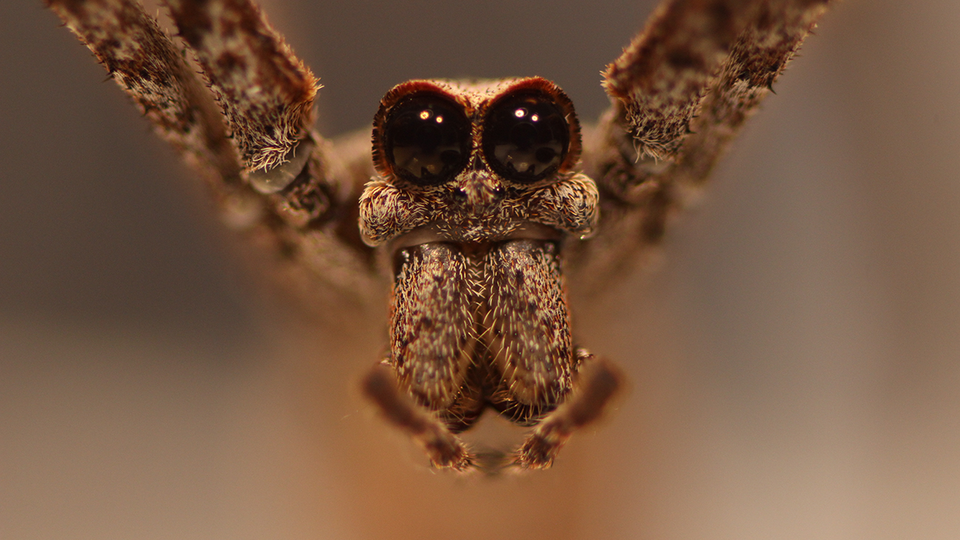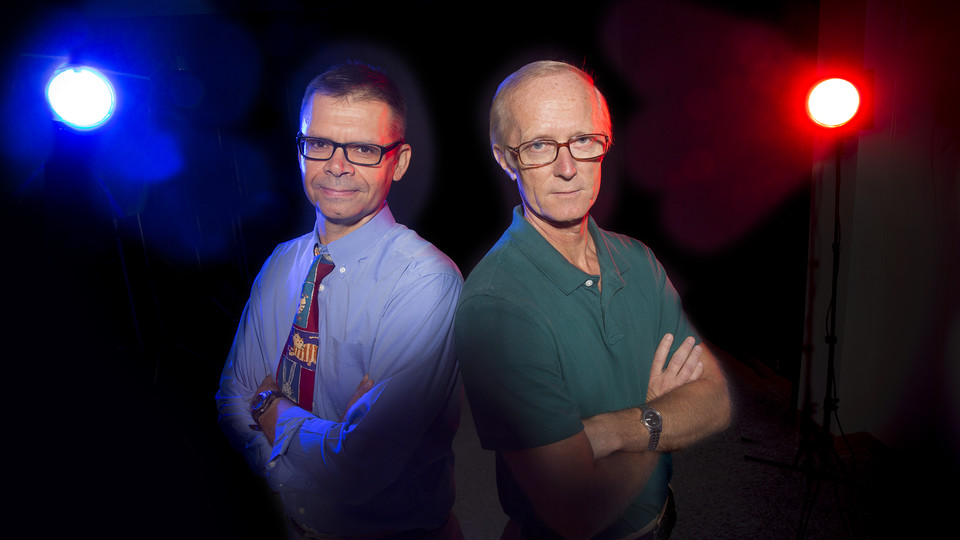
Jeepers creepers: Massive spider eyes shrink 25% in adulthood
May 1, 2017The male net-casting spider appears to shift his focus by going easy on the eyes as he enters adulthood, says a new study from the University of Nebraska-Lincoln.
As a juvenile, the male Deinopis spinosa spider boasts some of the biggest eyes among arachnids – all the better to see the nocturnal prey that he snares by casting a wide net of silk wrapped around his spindly forelegs.
But Nebraska arachnologists have found that when the male spider molts for the final time to reach maturity – losing the ability to spin his food-capturing net but gaining the ability to mate – his enormous secondary eyes shrink by an average of 25 percent. The secondary eyes of the female, which continues hunting as an adult, increase in diameter by 21 percent.
Lead author Jay Stafstrom previously found evidence that those secondary eyes evolved to help the net-casting spider catch ground-bound prey in the night. Yet the eyes’ solitary function – motion detection – may limit their usefulness beyond the sedentary hunting that the male ceases after reaching adulthood.
The male then has little choice but to begin searching for a mate, Stafstrom said, abandoning his nightly routine of dangling upside-down in favor of stumbling across the ground atop stilt-like legs not made for walking.
Stafstrom and co-author Eileen Hebets suspect that this abrupt plunge into the nightlife explains the dramatic shrinkage of the male’s secondary eyes, which seems to free up physiological resources better invested elsewhere.
“This huge behavioral shift really is crazy,” said Stafstrom, a soon-to-graduate doctoral candidate in biological sciences. “If you’re a male, throughout all of your juvenile life, you’re a super-predator with huge eyes to catch prey.
“Then you mature, and it’s like, ‘Crap, now what?’ It’s such a 180-degree turn. Instead of being in one spot, staring at the ground, now you’re walking around. We don’t know how far they actually search to find females, but it’s far more walking than they typically do.”
It could also explain a disparity between the genders’ principal eyes, which are a fraction the size of the secondary eyes but help the spiders perceive forms and details. Whereas the female’s principal eyes grow by just a few percent after she molts into adulthood, the male’s expand by an average of 36 percent, as reported in the journal Scientific Reports.
“The really big eyes detect motion, but if the females are just sitting there, and males are wandering around, those eyes probably won’t help much,” Stafstrom said. “That made sense – that they’d be decreasing investment in motion detection.
“But this increase in the principal eyes was unexpected. How this is going to help a mature male out in the field is still really puzzling. They’re web-building spiders that can feel vibrations quite well, so they probably can already feel out where the female is when they arrive on her web. But it’s a tricky business – courting a female that might eat you – so maybe it decreases their likelihood of being eaten somehow.”
Interested in whether these shifting investment strategies might also extend to the brain, Stafstrom began the painstaking process of dissecting them. Fortunately for Stafstrom, German researcher Peter Michalik learned about the study while visiting Hebets’ lab. Michalik mentioned that his institution had a micro-computerized tomography scanner that could generate 3-D imagery of the brains without the need for dissection.
After receiving the images, Stafstrom compared the size of certain visual processing regions in both genders before and after the spiders’ transition to adulthood. He expected that the male spider’s investment in brain segments that process motion – the domain of the secondary eyes – would shrink along with those eyes. And it did: On average, the so-called optic neuropils constituted more than 12 percent of the juvenile male’s brain, compared with less than nine percent of the adult male’s.
This seemingly small divestment probably has a large impact, Stafstrom said, given that neurons require about 10 times more energy to function than do most other tissues. Shifting metabolic resources to more relevant tissues might ultimately spare the males some precious time to find a mate and procreate, he said.
“It’s very specific to neurons that staying in an energetically charged state – ready to fire – costs a lot,” he said. “So it’s like the saying: ‘If you’re not using it, lose it.’ If the male spiders don’t rely on motion detection to forage anymore, they should get rid of it. They’re going to die quicker if they don’t, most likely.”
This became especially apparent to Stafstrom after witnessing adult males unable to capture and eat crickets in captivity, a consequence of just how uncoordinated they are without their nets. He said it’s rare to see such an extreme transformation from versatile predator to feeble bystander, a fact that made D. spinosa an ideal case study of the dynamics between behavior and physiology.
“There are a lot of studies that have shown that, in different environmental niches, you can see different investment in sensory systems,” Stafstrom said. “But within an individual’s life span, seeing such a dramatic change is pretty uncommon.”



